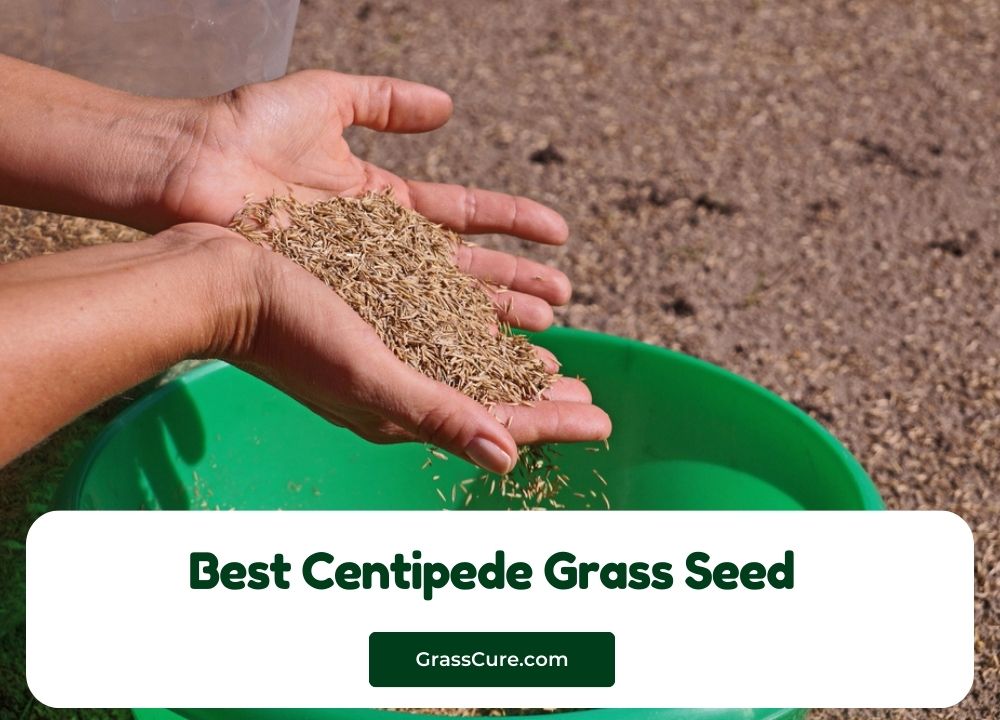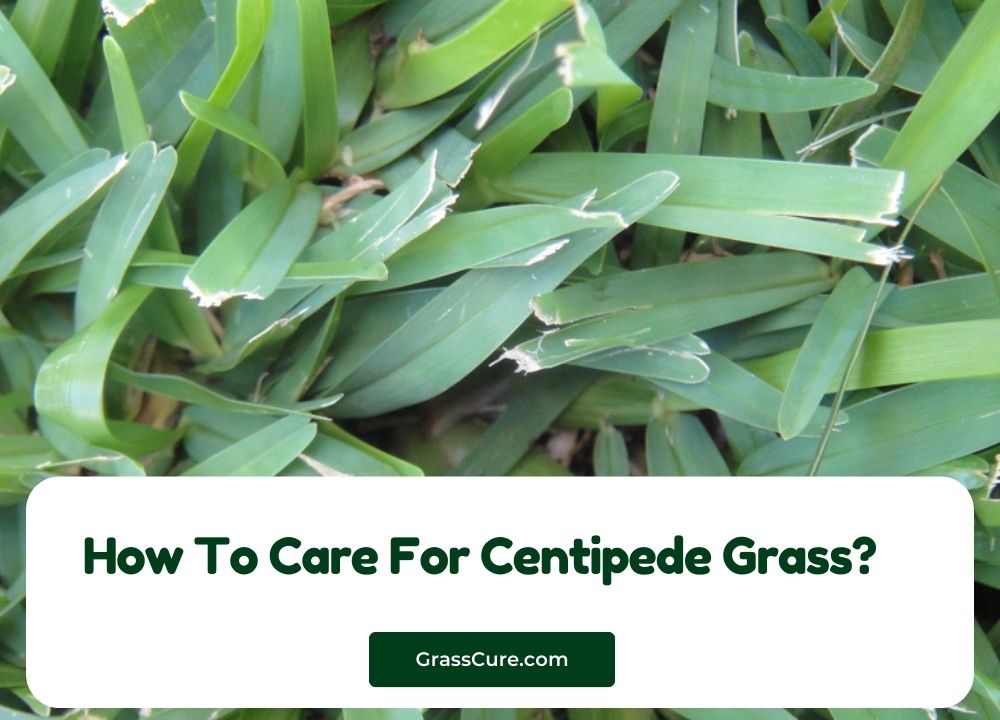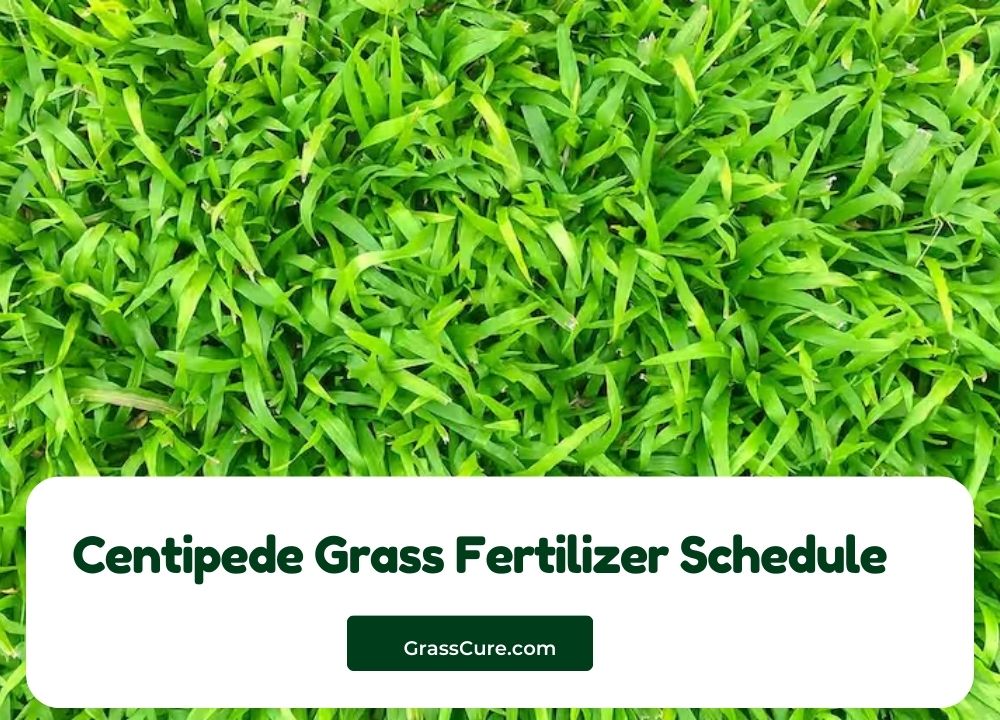Are you struggling with weeds taking over your centipede grass lawn? You’re not alone. Finding the right weed and feed product specifically formulated for centipede grass can make all the difference between a patchy, weed-infested yard and a lush, uniform lawn that’s the envy of your neighborhood.
Centipede grass requires special care. Its low maintenance reputation comes with specific nutritional needs that differ from other grass types. Using the wrong product can damage your lawn instead of helping it thrive.
In this comprehensive guide, we’ll explore the top weed and feed products designed specifically for centipede grass, highlighting their pros, cons, and ideal use cases so you can make an informed decision for your lawn care needs.
Contents
- Understanding Centipede Grass and Its Unique Needs
- What to Look for in Weed and Feed Products for Centipede Grass
- Top 5 Weed and Feed Products for Centipede Grass
- Application Timing: When to Apply Weed and Feed to Centipede Grass
- Application Methods: Granular vs. Liquid Weed and Feed
- Common Weed Problems in Centipede Grass
- Special Considerations for Centipede Grass Care
- DIY Alternatives to Commercial Weed and Feed
- Our Top Pick: Fertilome Centipede Weed & Feed 15-0-15
- Runner-Up: The Andersons Premium Weed and Feed
- Best Budget Option: Spectracide Weed & Feed Ready-to-Spray
- Final Thoughts on Selecting the Best Weed and Feed for Your Centipede Lawn
- FAQ: Weed and Feed for Centipede Grass
Understanding Centipede Grass and Its Unique Needs
Centipede grass thrives in warm climates with acidic soil conditions. Native to China and Southeast Asia, it has become popular across the southern United States due to its heat tolerance and minimal maintenance requirements.
Unlike other grass varieties, centipede grass:
- Prefers acidic soil (pH 5.0-6.0)
- Requires less nitrogen than other grass types
- Can turn yellow when over-fertilized
- Grows best with iron supplementation
- Has shallow roots making it susceptible to certain weeds
These unique characteristics mean you need specialized products for proper care. Regular weed and feed formulations often contain too much nitrogen or the wrong herbicides for centipede grass, which can stress or damage your lawn.
What to Look for in Weed and Feed Products for Centipede Grass
The ideal weed and feed product for centipede grass should include:
- Lower nitrogen content – Centipede grass needs less nitrogen than other grass types
- Higher potassium levels – For improved drought and stress tolerance
- Iron supplements – To prevent yellowing (chlorosis)
- Herbicides safe for centipede grass – Not all weed killers are safe for this grass variety
- Acidic pH support – To maintain ideal soil conditions
With these factors in mind, let’s examine the top products currently available for centipede grass care.
Top 5 Weed and Feed Products for Centipede Grass
1. Fertilome Centipede Weed & Feed 15-0-15 (16 lbs.)

Fertilome’s Centipede Weed & Feed stands out as the only product in our lineup specifically formulated for centipede grass, making it our top recommendation for most homeowners.
The 15-0-15 NPK ratio provides the perfect balance of nitrogen and potassium without phosphorus, which aligns perfectly with centipede grass requirements. The nitrogen promotes healthy, controlled growth while the potassium strengthens the grass against drought and disease.
This formula contains selective herbicides that target common centipede grass weeds while remaining gentle on the grass itself. Users report excellent results against dandelions, clover, chickweed, and other broadleaf weeds.
Pros:
- Specifically formulated for centipede grass
- Perfect NPK ratio (15-0-15) for centipede grass health
- Contains iron to prevent yellowing
- Effective against common centipede lawn weeds
- Promotes deep green color without excessive growth
Cons:
- More expensive than general-purpose products
- Limited availability in some regions
- Requires careful application to prevent burning
Best For: Homeowners who want a targeted solution specifically designed for centipede grass without compromises.
Application Tips: Apply when weeds are actively growing and the lawn is moist to maximize herbicide absorption. Water lightly after application to activate the product.
2. The Andersons Premium Weed and Feed 24-0-16 (18 lb)
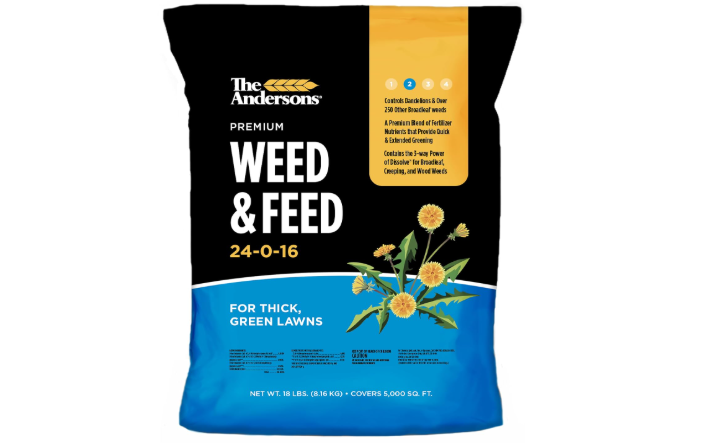
The Andersons Premium Weed and Feed brings professional-grade lawn care to homeowners with centipede grass. While not exclusively for centipede grass, its formula works well when properly applied.
The higher nitrogen content (24%) means you’ll need to apply this product sparingly on centipede grass to avoid over-fertilization. However, the 16% potassium content helps build stronger root systems and improves stress tolerance, which benefits centipede grass during drought conditions.
This premium formula includes multiple herbicides that target over 200 weed varieties, including many that commonly invade centipede lawns.
Pros:
- Professional-grade formula with enhanced weed control spectrum
- High potassium content for improved stress tolerance
- Covers up to 5,000 square feet
- Slow-release nitrogen for extended feeding
- Fine granules for even distribution
Cons:
- Higher nitrogen than ideal for centipede grass (use at reduced rate)
- Premium price point
- Requires precise application to avoid over-fertilization
Best For: Lawns with severe weed problems that need aggressive treatment while still supporting grass health.
Application Tips: Use at 75% of the recommended rate for centipede grass to avoid nitrogen burn. Apply during morning hours when dew is present for better adhesion to weed foliage.
3. Scotts Turf Builder Weed & Feed3 (14.29 lbs.)
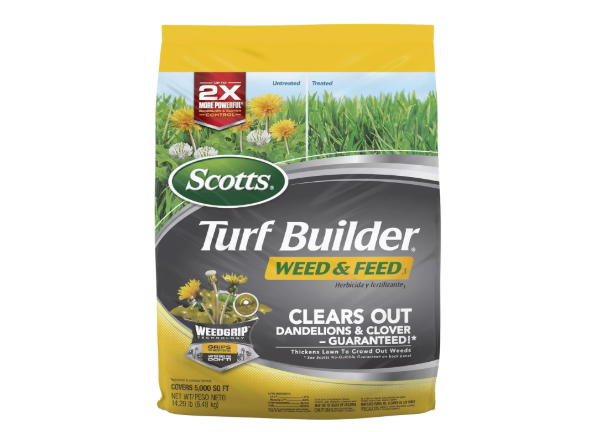
Scotts Turf Builder Weed & Feed3 offers a reliable option for centipede grass owners seeking a widely available product. While designed for all grass types, it can be used effectively on centipede grass with adjusted application rates.
This formula targets dandelions and clover—two common centipede grass invaders—plus many other broadleaf weeds. The WeedGrip Technology penetrates tough weed surfaces for effective control even on established weeds.
The fertilizer component feeds your lawn while the herbicides work on weeds, promoting thicker grass that naturally crowds out future weed growth.
Pros:
- Widely available at most garden centers and home improvement stores
- Effective against dandelions and clover
- Covers up to 5,000 square feet
- Easy-to-follow application instructions
- Begins working immediately with visible results within days
Cons:
- Not specifically formulated for centipede grass
- May contain more nitrogen than centipede grass needs
- Some users report inconsistent results on certain weed types
Best For: Homeowners who want a readily available product from a trusted brand with adjustment for centipede grass.
Application Tips: Apply at 3/4 the recommended rate for centipede grass. Use when weeds are actively growing and temperatures are between 60-90°F for best results.
4. Scotts Turf Builder Triple Action (11.31 lbs.)
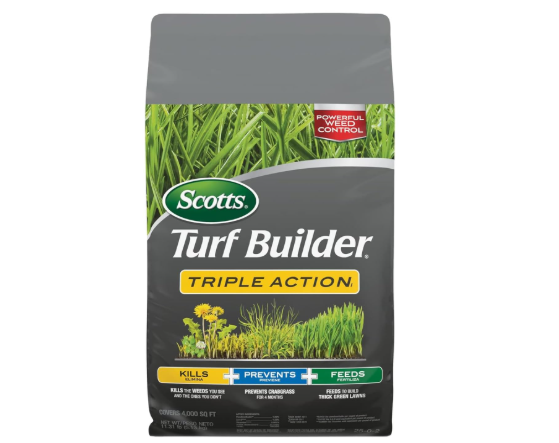
Scotts Turf Builder Triple Action provides three lawn care benefits in one application: fertilizer, weed control, and crabgrass prevention. This multi-action approach makes it valuable for centipede grass owners battling multiple lawn issues simultaneously.
The pre-emergent component helps prevent crabgrass and other grassy weeds from germinating, while the post-emergent herbicides target existing broadleaf weeds. The fertilizer promotes grass recovery in areas where weeds have been eliminated.
For centipede grass, this product offers good versatility but should be applied at reduced rates due to the higher nitrogen content than centipede ideally needs.
Pros:
- Three-in-one formula saves time and money
- Prevents crabgrass while killing existing weeds
- Covers up to 4,000 square feet
- Season-long prevention of new weeds
- Strengthens lawn against heat and drought
Cons:
- Not specifically formulated for centipede grass
- Higher price point per square foot
- May over-stimulate growth if applied at full rate
Best For: Early season application when both weed prevention and treatment are needed.
Application Tips: Apply in early spring before soil temperatures reach 55°F for crabgrass prevention benefits. Use at 75% of the recommended rate for centipede grass.
5. Spectracide Weed & Feed 20-0-0 (Ready-to-Spray) (32 fl oz)
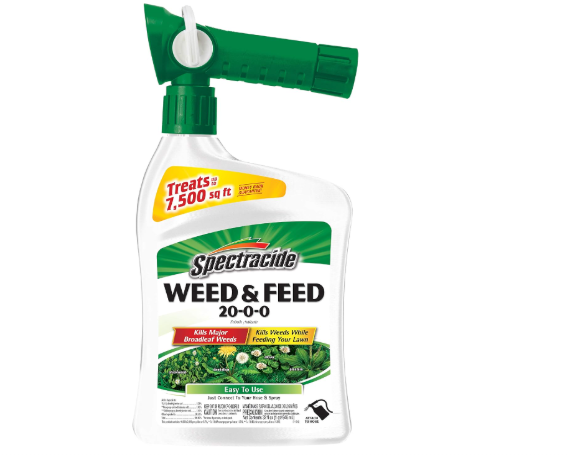
Spectracide’s liquid Weed & Feed offers a convenient alternative to granular products. The ready-to-spray formulation attaches directly to your garden hose for quick and easy application across your centipede lawn.
With a 20-0-0 NPK ratio, this product focuses primarily on nitrogen delivery and weed control without phosphorus or potassium. While the nitrogen content is higher than ideal for centipede grass, the liquid application allows for lighter, more controlled feeding compared to granular products.
The herbicide component targets over 250 common weeds, including many that typically invade centipede grass lawns.
Pros:
- Easy hose-end sprayer application
- No measuring or spreader required
- Budget-friendly option
- Rapid action on weeds (results visible within 24 hours)
- Good coverage with minimal effort
Cons:
- High nitrogen, no potassium (not ideal for centipede’s nutritional needs)
- Less precise application compared to granular products
- May require more frequent applications
- Covers less square footage than granular alternatives
Best For: Small centipede lawns or spot treatment of problem areas when convenience is a priority.
Application Tips: Apply during windless days to prevent drift. Use early in the morning when dew is present but rain is not expected for 24 hours. Consider diluting the application slightly for centipede grass by moving at a slightly faster pace during application.
Application Timing: When to Apply Weed and Feed to Centipede Grass
Timing your weed and feed application correctly can dramatically improve results while minimizing potential damage to your centipede lawn:
Spring (Best Time):
- Apply when soil temperatures consistently stay above 65°F
- Wait until after the second or third mowing of the season
- Target application when weeds are young and actively growing
- Apply 6-8 weeks after any pre-emergent herbicide application
Summer:
- Avoid applications during periods of extreme heat (above 90°F)
- If necessary, apply in early morning or evening
- Water thoroughly before application if soil is dry
- Use reduced rates during summer stress periods
Fall:
- Apply 6-8 weeks before first expected frost
- Focus on potassium-rich formulas for winter hardiness
- Target perennial weeds which are vulnerable during fall
Winter:
- Avoid application during dormancy periods
- If lawn shows winter weeds, use only herbicide-only products
For centipede grass specifically, limiting applications to 1-2 times per year prevents over-fertilization while still providing adequate weed control.
Application Methods: Granular vs. Liquid Weed and Feed
Both granular and liquid weed and feed products have their place in centipede lawn care:
Granular Products (Fertilome, Andersons, Scotts):
- More precise control over application rates
- Typically longer-lasting results
- Better for large lawn areas
- Require spreader equipment
- Must be applied to wet grass for herbicide adhesion
- Need watering-in for fertilizer activation
Liquid Products (Spectracide):
- Faster initial results on weeds
- No specialized equipment needed beyond a hose
- More uniform coverage
- Easier application in tight spaces
- Typically need more frequent application
- Weather dependent (need dry conditions after application)
For centipede grass, granular products often provide better long-term results due to the slower release of nutrients, which aligns with centipede’s preference for moderate feeding.
Common Weed Problems in Centipede Grass
Centipede grass faces specific weed challenges that good weed and feed products should address:
Broadleaf Weeds:
- Dandelions
- Clover
- Chickweed
- Henbit
- Dollar weed
Grassy Weeds:
- Crabgrass
- Annual bluegrass
- Nutsedge
- Bahiagrass
- Dallisgrass
Most Problematic: Nutsedge and bahiagrass present particular challenges as they share similar growing conditions with centipede grass. Look for products specifically mentioning these weeds for best results.
Special Considerations for Centipede Grass Care
Beyond choosing the right weed and feed product, consider these additional factors for successful centipede lawn care:
Soil Testing: Test your soil pH before application. Centipede grass thrives in acidic soil (pH 5.0-6.0). Most weed and feed products work best when soil pH is properly balanced for your grass type.
Proper Mowing Height: Maintain centipede grass at 1.5-2 inches tall. Mowing too short weakens the grass and allows more weeds to establish.
Watering Practices: Water deeply but infrequently (about 1 inch per week) to encourage deep root growth that helps crowd out weeds naturally.
Fall Iron Applications: Consider supplemental iron applications in fall to prevent winter yellowing without stimulating late-season growth.
DIY Alternatives to Commercial Weed and Feed
For those preferring natural approaches:
Corn Gluten Meal:
- Natural pre-emergent that suppresses weed germination
- Provides nitrogen to the lawn
- Apply in early spring and fall
Iron Sulfate + Organic Fertilizer:
- Provides iron for green color without excessive nitrogen
- Supports acidic soil conditions centipede grass prefers
- Won’t kill weeds but strengthens grass to compete better
Vinegar + Dish Soap Spot Treatment:
- For individual weeds in centipede lawns
- 30% horticultural vinegar (not household vinegar)
- Add 1 tablespoon dish soap per gallon
- Caution: Will kill any grass it contacts
These alternatives typically require more frequent application and won’t provide the same immediate results as commercial products.
Our Top Pick: Fertilome Centipede Weed & Feed 15-0-15
After thorough evaluation, Fertilome Centipede Weed & Feed emerges as the clear winner for centipede grass lawns. Its targeted formulation specifically addresses centipede grass needs while effectively controlling common lawn weeds.
The balanced 15-0-15 NPK ratio provides exactly what centipede grass requires: moderate nitrogen for controlled growth, no phosphorus to prevent runoff issues, and ample potassium for stress tolerance and root development.
While slightly more expensive than general-purpose options, the specialized formula prevents the potential damage that can occur from using products not designed for centipede grass, making it the most cost-effective choice long-term.
Runner-Up: The Andersons Premium Weed and Feed
For lawns with severe weed problems, The Andersons Premium Weed and Feed offers exceptional weed control capability while still supporting grass health when applied at the correct rate. Its higher potassium content benefits centipede grass stress tolerance, though care must be taken with the nitrogen levels.
Best Budget Option: Spectracide Weed & Feed Ready-to-Spray
For smaller lawns or those on a budget, Spectracide’s liquid formulation provides a convenient and affordable entry point to weed control and feeding. While not ideal nutritionally for centipede grass, proper application techniques can mitigate potential issues.
Final Thoughts on Selecting the Best Weed and Feed for Your Centipede Lawn
Choosing the right weed and feed for centipede grass requires balancing effective weed control with the specific nutritional needs of this unique grass variety. The products reviewed here each offer different strengths depending on your lawn’s specific situation.
Remember that even the best product can’t overcome poor lawn care practices. Combine your weed and feed application with proper mowing height, appropriate watering, and regular maintenance for truly outstanding results.
By understanding centipede grass’s specific requirements and selecting products that align with these needs, you’ll develop a thicker, healthier lawn that naturally resists weed invasion while maintaining that attractive low-maintenance quality that makes centipede grass so popular.
Want to learn more about caring for your specific grass type? Check out our other guides on seasonal lawn care, grass-specific maintenance schedules, and organic lawn care alternatives.
FAQ: Weed and Feed for Centipede Grass
Q: How often should I apply weed and feed to centipede grass?
A: Limit applications to 1-2 times per year. Centipede grass requires less fertilizer than other grass types, and over-application can lead to thatch buildup and yellowing. Spring application is most important, with a light fall application optional in established lawns.
Q: Will regular weed and feed products hurt my centipede grass?
A: Many general-purpose weed and feed products contain too much nitrogen or herbicides not suitable for centipede grass. Always look for products specifically mentioning centipede grass on the label or use regular products at a reduced rate (about 75% of recommended).
Q: Why does my centipede grass turn yellow after applying fertilizer?
A: Yellowing often indicates iron chlorosis caused by over-fertilization. Centipede grass requires less nitrogen than other grasses. Use low-nitrogen formulas (first number in the N-P-K ratio) and products containing supplemental iron to maintain green color without excessive growth.
Q: When is the best time to apply weed and feed to centipede grass?
A: The optimal time is late spring (May-June) when the grass is actively growing but weeds haven’t yet established deep root systems. Soil temperature should consistently remain above 65°F, and application should occur after the second or third mowing of the season.
Q: Can I use weed and feed on newly planted centipede grass?
A: Wait until after the third mowing or until the grass has been established for at least 3 months before applying any weed and feed product. Young centipede grass is particularly sensitive to herbicides and can be damaged by premature application.
Q: How do I calculate how much product I need for my lawn?
A: First, calculate your lawn size in square feet (length × width). Most products specify coverage rates (typically 5,000 sq ft per bag for granular products). For centipede grass, consider using about 75% of the recommended application rate unless the product is specifically formulated for centipede grass.
Q: Should I water my lawn before or after applying weed and feed?
A: For granular products, lightly water the lawn before application so herbicides stick to weed leaves. After application, don’t water for 24-48 hours to allow herbicides to work, then water lightly to activate the fertilizer component. For liquid products, apply to dry grass and don’t water for the period specified on the product label.
Q: Will weed and feed kill crabgrass in my centipede lawn?
A: Most post-emergent weed and feed products are designed to kill broadleaf weeds, not grassy weeds like crabgrass. For crabgrass control, look for products containing pre-emergent herbicides applied in early spring, or specialized products specifically mentioning crabgrass control on established lawns.


